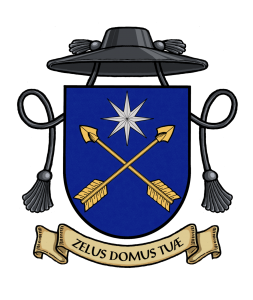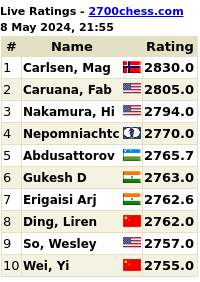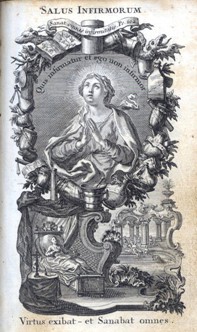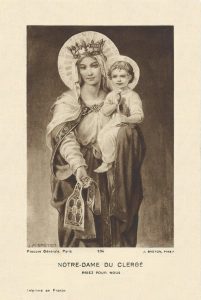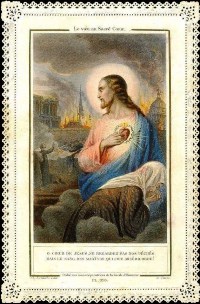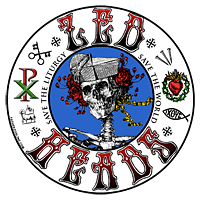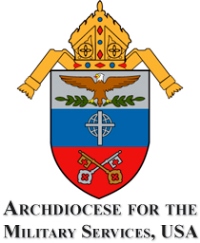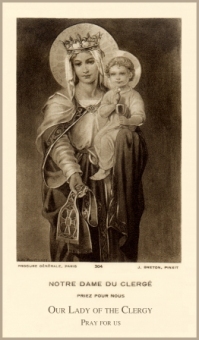What Does the Prayer Really Say? Trinity Sunday
ORIGINALLY PRINTED IN The Wanderer in 2003
Some feedback from FA in Italy (my translation): “I attended the Holy Mass celebrated by His Eminence Card. Castrillón-Hoyos in S. Maria Maggiore: it was a beautiful day. There were at least 200-2500 people, and not just the usual gloomy and sour traditionalists… there were many young men and women, some with veil and some not, but all very happy to be there and very focused. There were many families with young children. Some pessimists wanted to pick at details in order to find flaws in this special day. I think that in the main it was a great success both for the Curia and for the more reasonable traditionalists…. The prevailing mood was one of gratitude toward the Holy Father. For one day, some broken hearts bled a little less and some people discovered that the Church is more complex than they had dreamed, for good or for bad. It is certain that if the Church “lives from the Eucharist” (Ecclesia de Eucharistia) then some would do well to read the Holy Father’s writings and rethink how Mass ought to be celebrated and how the Church is to be built up among the people.” Thanks, FA. Your comments underscore for me the contrast between the false and feigned “tolerance” preached by many of the (seemingly) more progressive stripe and, on the other hand, the fruits of an authentic diversity and tolerance in the Church. Also, as you point out, the way we celebrate Mass is inextricably connected with how the Church is built up amongst God’s people and, therefore, what characteristics that people of God will have and reveal to the world around them. Of course, the use of Latin in both the older rite and the Novus Ordo will be central to this, but so will celebrations using the vernacular, which isn’t going to go away. Thus, translations remain an issue of urgent and critical importance even for those who rarely or never attend Novus Ordo Masses in the vernacular. Good translations will benefit everyone because they will serve to build up the Body of Christ. The whole point is how, as Christians humbly obedient to our vocations of building the living temple the Church, are we going to build up the people of God for His glory and our salvation? Is this sacred calling to be served by presenting anything less than the true and beautiful content of all the Church has to give, in her liturgy and her teachings? Also, how is it to be served by acrimony, pettiness and bickering?
POST COMMUNIONEM
LATIN (2002 Missale Romanum):
Proficiat nobis ad salutem corporis et animae,
Domine Deus noster, huius sacramenti susceptio,
et sempiternae sanctae Trinitatis
eiusdemque individuae Unitatis confessio.
This was the Postcommunio of the Feast of the Most Holy Trinity in the 1962MR. There is a pleasant rhyme herein of susceptio and confessio, three syllable words preceded by words of four syllables and both deserving a little closer inspectio.
The indomitable Lewis & Short Dictionary indicates that a susceptio is “a taking in hand, undertaking” and “an acceptance”. This is a substantive derived from the verb suscipio. The deponent verb confiteor gives us the noun confessio, which means in its basic meaning “a confession, acknowledgment” and thus also “a creed, avowal of belief” and more specifically in the Latin Vulgate “an acknowledgment of Christ” (Rom 10:10, Heb 3:1) and therefore in the early Church “an acknowledgment of Christ under torture; and hence, “torture, suffering for religion’s sake” (Lactantius, De mortibus persecutorum 1).
A review of vocabulary is always important and can provide some new insights into the deeper meaning of a prayer, but often the structure or word order can give clues as well. Today we have one main very proficiat, coming from proficio (“to profit, derive advantage” and “to be useful, serviceable, advantageous, etc.,”) an old friend of WDTPRS vets. This noun has two subjects, susceptio and confessio. Susceptio is further specified by huius sacramenti (“reception of this sacrament”) and confessio is delineated in two ways, Trinitatis (“of the Trinity”) and Unitatis (“of the Unity”). Often in Latin we will have a sentence structure of noun and then, frequently at the very end, main verb, with many other clauses and material in between which can be pealed open like layers of an onion. Here, the verb is out front as the very first word and the final subject noun is the last word. For me, this structure emphasizes the nouns susceptio and especially confessio and the intimate relationship between them as well as the concepts that are attached to them, that is, the intimate bond at the moment of Communion between our reception of Christ’s Body and Blood with our “confession” of a God who is Triune – Three distinct divine Persons having one indivisible divine nature. Furthermore, the theme of distinct elements in indivisible unity is even carried into the effect we hope for from the act of Communion in Mass: “health” of both “body and soul”. Latin salus is “a being safe and sound; a sound or whole condition, health, welfare, prosperity, preservation, safety, deliverance” and also in Christian contexts such as the Vulgate “salvation, deliverance from sin and its penalties. It can be rendered as both “health” and “salvation”.
ICEL (1973 translation of the 1970MR):
Lord, God,
we worship you, a Trinity of Persons, one eternal God.
May our faith and the sacrament we receive
bring us health of mind and body.
LITERAL TRANSLATION:
May the reception of this sacrament, O Lord our God,
and also the confession of our faith in the holy everlasting Trinity
and of the undivided Unity of the same,
profit us for the salvation of body and soul.
We have pairs of terms in this Latin prayer which underscore relationships: corpus and anima, susceptio and confessio, Trinitas and Unitas. Each element is necessary for and balances the other.
Humans are by God’s design persons comprised of both body and soul (corpus et anima). By contrast, angels are persons having only a soul but no body. The temporary separation of body and soul results in death. Their reunion at the end of time produces the resurrection of the flesh. God loves us so much that he provides sustenance for both constituent elements. In Holy Communion we have a food which our body transforms into what it is (flesh and blood) and which transforms our souls in to what It is (more perfect images of the Triune God after the Person of the Risen Christ). For us to participate in this mysterious exchange of transformations we must both inwardly and outwardly conform to the transcendent reality we seek to embrace and be embraced by. Thus, before we can receive the transformed and transforming Host in Communion, we must be in an authentic communion of faith both with a larger group of believers and partakers called the Church and we must be interiorly disposed to receive the invisible benefits that the outward signs and actions portend. We must make a true confession and profession of faith consistent with our interior landscape.
In the mystery of the Unity and Trinity of God we believe that, from all eternity and before material creation and even time itself, the One God who desired a perfect communion of love expressed Himself in a perfect Word, containing all that He is. The Word God uttered was and is a perfect self-expression, also perfectly possessing every characteristic of the Speaker: being, omniscience, omnipotence, truth, beauty, and even personhood. So, from all eternity there were always two divine Persons, the God who spoke and the Word who was spoken, the God who Generates and the God who is Generated, true God with and from true God, Begetter and Begotten, Father and Son. There was never a time when this was not so. These two Persons eternally regard and contemplate each other. From all eternity they knew and loved each other, each embracing the other in a perfect gift of self-giving. And since the self-gift of these perfect and divine Persons, distinct by sharing one divine nature, is a perfect self-gift perfectly given and perfectly received, the very Gift between them also contains all that each of the Persons have: being, omniscience, omnipotence, truth, beauty, and even personhood. Thus, from all eternity there exist three distinct divine Persons yet having one indivisible divine nature, Father, Son and the perfect self-gift of love between them, the Holy Spirit. This is the foundational saving doctrine we believe in as Christians. At the core of everything else we believe in and hope for, we will find this mysterious doctrine of divine relationship, the Triune God.
By baptism we images of God are brought into a new relationship with this Triune God. We become the adoptive children of the heavenly Father, members of the Son our Lord Jesus Christ in the Mystical Person of the Holy Church which He founded. The Holy Spirit makes of us His dwelling so that all the divine Persons are present to us and in us, informing all that we are, do and say. Our membership in the Church opens the way to an eternal relationship of glory and praise with the Trinity. The promise and token of this eternal reward is how we, as members of a Church of believers professing a common Faith, can take into our bodies, and thus into our souls, the already transformed Body and Blood of the Second Person, the one who unites in His divine Person both the eternity divinity of God and the finite two-fold nature of man. For this to have taken place and to make it possible for us to “return back” to the Father, the Second Person “went forth” from the Father in a new way, this time in the context of time and space. In taking us up in our human nature, He made an act of self-empyting. In filling us with divine gifts in Holy Communion, Christ renews (not re-sacrifices) His Sacrifice, His giving forth and His taking back up again.
In Holy Mass we are asked to “take up and give forth” (susceptio et confessio). In our confessio we make an exterior expression, giving forth outwardly what we are within. “I confess (confiteor) to almighty God…” is just a scratching of the surface, though an important one. For St. Augustine in his great prayer and autobiographical “giving forth” (The Confessions) the word confessio carried layers upon layers of meaning. As we learn in the magisterial Augustinus Lexicon for Augustine confessio simultaneously and in a fluid way bore three main concepts: confession of sin, praise of God, and profession of faith. For Augustine all created things in the universe, even inanimate things, both give witness to God and give Him glory: “Respondent tibi omnia: Ecce vide, pulchra sumus. Pulchritudo eorum confessio eorum… All things respond to you, O God: ‘Behold! See! We are beautiful!’ Their beauty is their hymn of praise/demonstration that you are God/admission that they are not God” (s. 241, 2 – PL 38: 1133). Are we beautiful at Mass?
What we do outwardly in our bodies and what we do interiorly in our souls must conform to the Trinity in whose image we are made. Receiving Holy Communion is a profound statement of who we are and what we hope to be. The act of reception must be consistent with who we are and what we are about in life. That act of reception must inform and transform all other acts which, in their turn, are a living “confession”, bearing witness, giving praise, and recognizing our true status before God which can often involve confession of sins. Similarly every act of praise and testimony of the Church in her liturgy should reflect beautifully and accurately all that the Church professes and longs for. Every liturgical gesture, church building, vestment, musical prayer, text and translation must be like a gift simultaneously coming forth from the Sacred Heart of the Son and given to us for our benefit as well as a response we make to the glory of the Triune God who gives them. “Their beauty is their praise.”

